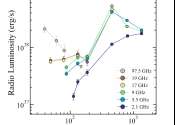Astronomers significantly impact the climate by traveling to conferences, say researchers
In 2019, global travel to international academic conferences in the field of astronomy caused the equivalent of 42,500 tons of climate-damaging CO2 emissions. This equates to an average of one ton of CO2 per participant and ...









